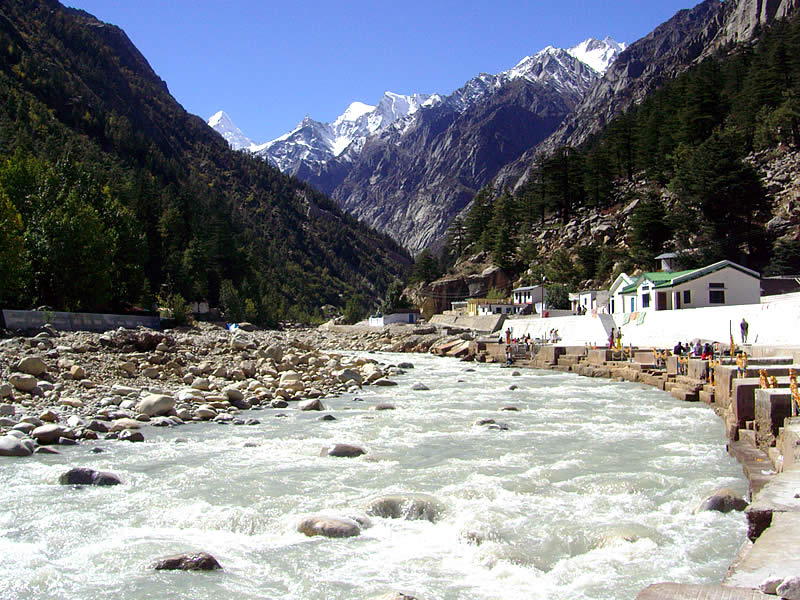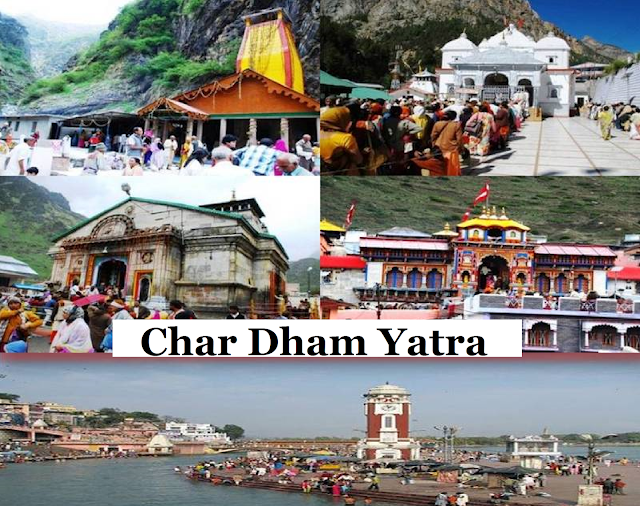The
Char Dham Yatra literally translated as 'the four abodes/seats', means 'the
circuit of four abodes/seats'. It is very popular as well as important Hindu
pilgrimage tour circuits which included visit to Kedarnath, Badrinath, Yamunotri
and Gangotri. All these eminent holy destinations are being situated in the
amazing Himalayan foothills of Uttarakhand at different districts. In India it
is the most devoted as well as featured part of spiritual trip. Generally, chardham
yatra tour starts each year in April to May and closes for winters mainly in
the third week of November.
This
dignified tour was being started thousands years ago in 8th Century by the
great philosopher and reformer Adi Shankaracharya and ever since then the Chardham
tour is welcoming abundant pilgrims at wonderful locations. This journey starts
from Haridwar (Uttarakhand), an ideal gateway to God and can be reached to different
places for Char Dham.
It
is believed that undertaking a voyage to these places will wash away one's sins
as well as make sure liberate from the cycle of birth and death. These all “Dhams”
are located in the icy Garhwal ranges and considered as the most blessed of all
Himalayan ranges. The Chardham yatra must be done from left to right. You
should begin with Yamunotri, to Gangotri, Kedarnath and finished the journey at
Badrinath. This route pursues the Hindu ritual of “parikrama” or “clockwise
circumambulation.”
CharDham Yatra Opening Dates 2018
YAMUNOTRI
|
18 APRIL 2018
{Tentatively}
|
GANGOTRI
|
18 APRIL 2018 {Akshay
Tritya}
|
KEDARNATH
|
29 APRIL 2018 AT
6:15AM
|
BADRINATHJI
|
30 APRIL 2018 AT
4:30AM
|
# Yamunotri
Yamunotri
is situated at Uttarkashi at height of 3164 meters from the sea level. This
place is the initial source of Yamuna River and is surrounded by the snow
covered mountains and forests. The real source of Yamuna River mainly lies in
the Yamunotri Glacier at an elevation of 6,387 metres close to Bandarpunch
Peaks in Lower Himalayas.
Yamuna
River is counted amongst the 2nd largest River in India after Ganga
and this place is a part of the four sacred abodes in Chardham yatra. Yamunotri
is the place where the followers can find both the merger of hot as well as cold
environment. The environment of Himalayas is purified and chills with the icy
tides of the glaciers of River Yamuna. The sides remain warm up with the
thermal springs and are known as “Kunds” of Goddess Shakti. In the hot or thermal
springs raw rice is cooked and served into prasad.
- History
of Yamunotri Dham
The
Yamunotri temple is devoted to goddess Yamuna and the main divinity of the temple
is made up of Black marble. As per the Hindu mythology, it is supposed that
Yamuna is the daughter of Surya the Sungod and the sister of Yama (the god of
death). This beautiful temple was constructed in the 19th century by Maharani
Gularia who was from Jaipur after the temple has been shattered by Climate. The
Yamunotri Shrine was at first constructed by Maharaj Pratap Shah of Tehri
Garhwal on left shoreline of Yamuna River.


Apart
from this, a visit to Yamunotri temple is basically a full day trip from main
towns of Uttarakhand including Haridwar, Rishikesh or Dehradun. The temple is reachable
by 13 Kilometers trek from the place known as Hanuman Chatti and 6 Kilometer
from Janki Chatt for the best spiritual expedition. Moreover, there are numerous
holy shrines, temples and ashrams which are situated in and around the
Yamunotri Dham.
- Places to see in Yamunotri Dham
Saptarishi
Kund Lake
Surya
Kund
Janki
Chatti
Divya
Shila and many more.


- How to Reach Yamunotri?
By Air: The nearest airport to Yamunotri is
Jolly Grant Airport in Dehradun which is located at a distance of approx 210
kms. This airport is well connected to New Delhi with daily flights and taxis
are available from airport to Hanuman Chatti.
By Road: Trek in Yamunotri starts from Hanuman
Chatti. So, by road you can easily reach to Rishikesh from Delhi ISBT Kashmiri
Gate and from Rishikesh you can travel to Hanuman Chatti by bus which are
easily available.
By Rail: Dehradun, Rishikesh and Haridwar are
nearest railway stations and are about 150-200 kms far from Yamunotri. Moreover,
Dehradun, Rishikesh and Haridwar all these three places are very well connected
by railways networks with all over India. From railways stations taxis are
available till Hanuman Chatti.
# Gangotri

On
the banks of Bhagirathi River, Gangotri is situated at an altitude of 3100
meters above sea level. River Ganga is originated from the Gangotri and is
located in Uttarkashi district of Uttarakhand where thousands of disciples visit
there for washing away their sins in the urge of salvation. Ganga River is the
longest as well as most holy river in world. Gangotri is one of the important
Char Dham pilgrimage for people how follow Hindu religion and the chief origin
of the river is “Gaumukh”. Gaumukh is a glacier which is situated 19 km far
from Gangotri temple. In prehistoric time, the Ganga River is called as Bhagirathi
and gets the name Ganga from Devprayag onwards where the River Bhagirathi meets
with Alaknanda to form Ganga River.
- History
of Gangotri Dham
It
is said that the Ganga is a consequence of reward given by lord “Shiva” to the
king “Bhagirath” for his reparation, as per the Hindu Mythology. There was a
fact that the earth will be devastated if Ganga came down with all its full
force and Lord Shive caught her in his locks and slow down its force. There is
a holy stone near the Gangotri temple which mainly denotes the place where
Ganga at first come down to earth. Due to this reason only, River Ganga is also
known as the Bhagirathi. Furthermore,
the current temple which is there was built by a Gorkha Commander Amar Singh
Thapa in the 18th Century. During the time of construction of temple Gaumukh
Glacier was there but receded to it's current location due to the effects of
global warming. The holy place of Gangotri temple seems to very beautiful with delicate
20 ft structure finished of white granite.


Apart
from this, Gangotri is the home place of many small shrines, ashrams as well as
temples. There you will also find many shops from where you can buy Prasad as
well as small cans for carrying the holy water from Gangotri after Darshan. The
holy water of Ganga is pure and in hindu religion is used in pooja and prayers.
Additionally, Gangotri is the habitat place of many varieties of flora and
fauna.
The
Gangotri temple opens on the fortunate day of Akshay Tritiya which generally falls
in the month of May and closes on Bhai Duj which falls in the month of November
after Diwali. The temple closed for the rest of the 6 months when the goddess
is worshipped at Mukhwa, near Harsil.
- Places to see in Gangotri Dham
Gangnani
(52.3 kms)
Bhojbasa
(14 kms)
Bhaironghati
(10 kms)
Harsil
(25.1 kms)
Surya
Kund (0.1 km)
Dharali
(19 kms)
 |
Gaumukh
Glacier
|
- How to Reach Gangotri?
By Air: is Jolly Grant Airport in Dehradun is
the nearest airport which is located at a distance of approx 250 kms. You can
hire taxi from here to reach Gangotri.
By Road: Gangotri is very well connected by
motorable roads with Dehradun and Rishikesh.
By Rail: Rishikesh railways station is nearest
railways station to Gangotri and from here the distance of Gangotri is 234 kms.
# Kedarnath

Located
on the bank of Mandakini river, Kedarnath Temple in Rudraprayag district of
Uttarakhand is situated at an altitude of 3584 meters above sea level is one of
the holy pilgrimage centre in Northern India.
Kedarnath temple is a part of Char Dhams as well as Panch Kedar in
Uttarakhand state and is regarded as one of the 12 Jyotirlingas of Lord Shiva
in India. The well-known Jyotirlinga shrines are must visit places where Lord
Shiva emerged as a blistering column of light.
- History
of Kedarnath Dham
Very
famous temple Kedarnath is mainly devoted to manifestations of Lord Shiva.
Kedarnath is named after King Kedar who was believed to rule in the Satya Yuga.
It is a belief according to Hindu mythology that Kedarnath Dham is the place
where Lord Shiva forgives Pandavas from the offense of killing their own
cousins Kauravas in the clash of Kurukshetra war. As per the Puranas, the
Pandava brothers did a major reparation in Kedarnath to gratify Lord Shiva.
Previously the temple was built by Pandavas, and present temple was constructed
by Adi Shankaracharya. Just behind the temple there is also a samadhi of Adi
Shankaracharya.


Moreover,
Kedarnath is flanked by magnificent lofty peaks, making it the most distant
site among all four Char Dham holy places. The picturesque beauty of this
shrine attracts tremendous pilgrims from all over the world for seeking
blessings of Lord Shiva. During the season of winters, Kedarnath is closed for 6
months because of heavy snowfall and intense cold weather. The idols from the Shri
Kedarnath Dham are brought to Ukhimath and worshipped here for 6 months in
winters.
- Places to see in Kedarnath Dham
Phata
(31 kms)
Gandhi
Sarova (4 kms)
Gaurikund
Temple
Sonprayag
(20.4 kms)
Vasuki
Tal
Gaurikund
(16 kms)
Kedarnath
Helipad (0.7 km)

- How to Reach Kedarnath?
By Air: You can fly to Jolly Grant Airport,
Dehradun from Delhi and then travel by bus or taxi to reach Kedarnath from
there.
By Road: To reach Kedarnath by road you can
travel in bus from Delhi to Rishikesh and then further from here. You can also
hire a private taxi and the bus facilities are also available from Haridwar and
Rishikesh.
By Rail: If you want to reach Kedarnath by Rail network
then you will reach upto only Rishikesh. From there you have to travel further
by road. Distance of Kedarnath from Rishikesh is 216 kms.
# Badrinath

Badrinath
is an ideal illustration of dedication for humanity and mankind and is one of
the sacred shrines for Vaishnavites among the 108 divya desams personification
of Lord Vishnu. The Badrinath Temple is located at height of 3415 meters on the
bank of Alaknanada River in the Garhwal Hills.
Badrinath
town is also well known for its scenic beauty, dense forest, with pleasant
weather, Holy River, snow clad Mountains, with surrounding green valley which draws
the attention of tourists from india and abroad also. Hence, it is one the most
popular shrines of the Char Dham Yatra of Uttarakhand state.
- History
of Badrinath Dham
Initially
Badrinath temple was constructed by Adi Shankaracharya and he discovered the
idol of Badrinarayan in the Alaknanda River. But the present temple was constructed
in the 16th century by King of Garhwal. The idol is finished of the
Shaligram statue in the thoughtful pose and is the perfect site for the
Vaishnavites. Tourists are attracted by the impressive traditional carving in
the walls and ornament stones. The architecture look of Badrinath Temple is
same as the manifestation of Buddhist Vihara temple. It is believed that the
during the time of SatyaYug Lorad Shiva for thousands of years meditated here when
Goddess Lakshmi give shadow over her husband in the form of a tree named as “Badri”. Kedarnath and
Badrinath are believed to be the home of Lord Shiva. When you will enter at
this temple, there is a main idol of Lord Shiva on Bird known as Garud (considered
as the vehicle of Lord Badrinarayan). At the main sanctum there is a statue of mediated
Adi Shankaracharya as well as many god idols such as Bhakta Narada, Narayan and
many more. In addition to this, Badrinath town is also the element of Panch
Badri temples including Bhavishya Badri, Yog Dhyan Badri, Vriddha Badri and Adi
Badri together with Badrinath temple.

You
can also visit to Badrinath during the festivals such as Janam-ashtami, Kedar-Badri
Utsav and Mata Murti Ka Mela which are celebrated with lot of joy here. during
the winters the Badrinath temple remains closed as this places receives a heavy
rainfall.
- Places to see in Badrinath Dham
Pandukeshwar
(22.6 kms)
Mana
Village (4.4 kms)
Yogadhyan
Badri Temple (23 kms)
Neelkantha
Peak
Tapta
Kund (0.5 km)
Mata
Murti Temple (3 kms)
Bheem
Pul (3 kms)
Charan
Paduka (2.5 kms)
Narad
Kund (0.5 km)
Sheshnetra
(0.23 km)
Ganesha
Cave (4.5 kms)
Brahma
Kapal (0.5 km)
Panch
Dhara and Panch Shila (1 kms)
Vyas
Cave (5 kms)
Vasudhara
Falls (9 kms)
Alkapuri
Glacier (15 kms)
Satopanth
Lake (22 kms)
Surya
Kund Badrinath (0.5 km)
Saraswati
River (5 kms)

- How to Reach Badrinath?
By Air: to reach Badrinath by air you can fly
upto Jolly Grant Airport, Dehradun and from there you can get taxi to Rishikesh
and then travel by road in bus or taxi.
By Road: Badrinath is very well connected by
roads from all main destination of Uttarakhand. You can hire a taxi from
Haridwar or Rishikesh and buses are also available from these two places and
Dehradun also which is the capital of Uttarakhand state.
By Rail: You can travel to Haridwar, Rishikesh or
Dehradun by train and from there you can travel by taxi or buses to reach
Badrinath. Distance from Rishikesh to
Badrinath is 295 kms.
- Blog Post By: Neeta Sharma










1 Comments
Hi just wanted to leave an appreciation comment, as I was looking for some cool Travel stuff to read. Really enjoyed reading your blog. Keep up the good work. Thanks will look forward for more. Char Dham Yatra Packages Char Dham Yatra 4 Dham Yatra
ReplyDelete